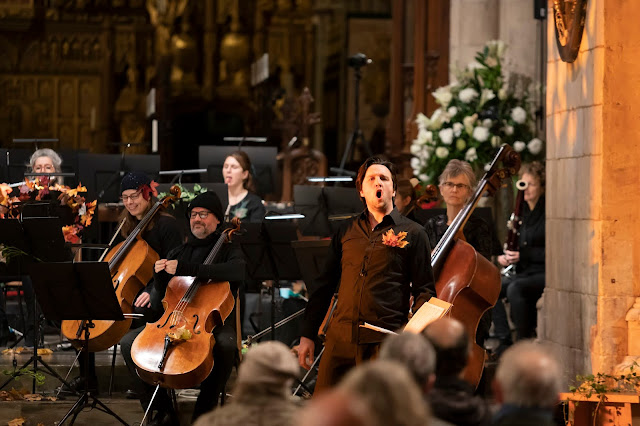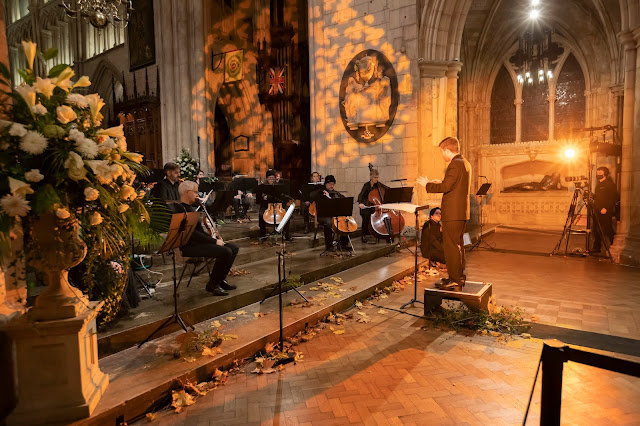 |
| Frances-Hoad: Scenes from the Wild - William Morgan, City of London Sinfonia, Geoffrey Paterson at Southwark Cathedral (Photo Nick Rutter for Apple and Biscuit Recordings) |
Frances-Hoad Scenes from the Wild; William Morgan, City of London Sinfonia, Geoffrey Paterson; Southwark Cathedral
Reviewed by Robert Hugill on 25 November 2021 Star rating: (★★★★)
A humungous achievement for all concerned; Frances-Hoad's remarkable 80-minute song cycle celebrating the orchestra's birthday, the natural world and the thoughts of a remarkable young man
City of London Sinfonia is celebrating its 50th birthday with a season of concerts, Origin, at Southwark Cathedral. For the third concert in the series on Thursday 25 November 2021, Geoffrey Paterson conducted City of London Sinfonia and tenor William Morgan in the premiere of Cheryl Frances-Hoad's Scenes from the Wild with a libretto by Amanda Holden based on Dara McAnulty's book Diary of a Young Naturalist.
A conservationist and an activist, Dara McAnulty's book explores the natural world throughout the seasons, his fascination with flora and fauna being tied up with both his activism and his autism. Holden's libretto distilled the book down to 26 episodes, spread across the four seasons of a year (2018 to 2019). The result was something of a tour-de-force for both composer and performers, as the song cycle lasted around 80 minutes, as well as a bit of a challenge for listeners.
The choice of the book and the theme of the work was deliberate, so that Scene from the Wild is intended to reflect on the orchestra's extensive participation work in mental health settings, a belief in inclusion and music for all and care for the environment.
McAnulty's writes in poetic prose, and his thoughts on particular aspects of the natural world can develop into poetic meditations, anger about loss of habitat or aspects of living with autism. Frances-Hoad reflected this by giving the music a free-form, rhapsodic nature, with each song/episode often featuring a solo moment for particular instruments from the orchestra. Though writing for quite a small chamber orchestra, 10 strings, single woodwind, two horns, trumpet and percussion, Hoad managed to create a series of atmospheric and imaginative textures, as well as bringing the feel and sound of the natural world into the music without ever feeling cornily descriptive.
The presentation was carefully considered, the scene dressed with autumnal leaves and movement director Sarah Dowling encouraged both tenor William Morgan and the various wind players of the orchestra to move around. This created a dynamism to the piece which meant that it shadowed into a theatre piece.
The writing for William Morgan was often in the form of lyric arioso, with Morgan seeming to confront or confide directly with the audience. The result was a sense of contrast, with a strong tenor line surrounded and coloured by the lovely orchestrations, and Frances-Hoad was sparing in her writing, sometimes Morgan was unaccompanied or simply had a dialogue with one of the wind soloists, and she was wonderfully deft at getting imaginative orchestral sounds using remarkably few players. Some moments developed into a form of poetic rapture, whilst in others the sense of spiky anger was prevalent, thus giving plenty of changes of mood and pace.
Morgan did a superb job, engaging us and developing a real sense of the personality of the narrator, a character addressing us directly. He paced himself well in what is a very long sing, and never seemed to tire whilst having the energy for the dynamic and dramatic moments. He was ably supported and partnered by Paterson and the orchestra, each person contributing significantly to the whole.
There were so many lovely moments to the piece, and you felt that Frances-Hoad's inspiration was positively verdant; clearly, McAnulty's poetic prose, as filtered by Amanda Holden, inspired her a lot. The music had a sort of free-form dynamism too it, allied to a very fine ear for orchestral textures and so many moments impressed. So, it feels a little churlish to comment that the work seemed rather too long. It is difficult to know where and what to cut, but I felt it would be stronger if the work was shorter, with a stronger sense of shape.
Whilst the presentation and the performance were beautifully thought through, one aspect seemed to have been somewhat neglected. The words. There were a lot of these, and Morgan worked superbly hard on the diction and a remarkable amount of text came over. But the acoustics of Southwark Cathedral are not idea for conveying words, and there were whole passages where one could barely get the gist of the argument. The libretto was available for download on your phone, though not many people were taking advantage of this (and spending 80 minutes glued to the phone during a performance is not ideal). I thought it a shame that opportunity was not taken to incorporate some or all of the words as projections as part of the presentation.

Frances-Hoad: Scenes from the Wild - William Morgan, City of London Sinfonia, Geoffrey Paterson at Southwark Cathedral (Photo Nick Rutter for Apple and Biscuit Recordings)
Scenes from the Wild represents a humungous amount of work and a terrific achievement. The sheer luxuriance of Frances-Hoad's imagination is almost overwhelming, and William Morgan in particular must be congratulated for bringing about the solo part. The work is getting two further performances on Saturday 27 November, but there is so much to this piece that I do hope that it is not simply an occasional work.
Never miss out on future posts by following us
The blog is free, but I'd be delighted if you were to show your appreciation by buying me a coffee.
Elsewhere on this blog
- How I wonder what you are: RR Bennett, Hindemith, RVW, Schubert, Mussorgsky, Barber, and Alex Groves at Re-Sung - concert review
- In the Garden of Polyphony: Israel Golani performs French Renaissance music for lute and guitar on Solaire Records - record review
- From complex juggling patterns to cartoon sound-tracks to Melville's Moby Dick; the inspirations behind Ryan Latimer's vividly coloured and richly energised music are many and varied - record review
- A that Ring focuses on the big issue of today, the refugee crisis: Stefan Herheim's new production of Wagner's Ring cycle at Deutsche Oper, Berlin - opera review
- Light of Shore: debut disc from Belfast-based composer Anselm McDonnell - record review
- From jazz and groove to classical: I chat to composer and improvising trombonist Alex Paxton about his three recent works nominated for this years Ivors Composer Awards - interview
- From a puppet 'Liederspiel' to men behaving badly: Thomas Guthrie and Barokksolistene at Temple Music - concert review
- From youthful jeux d'esprit to late, late masterworks: Saint-Saens' chamber music with winds is well-worth exploring - record review
- A disc to make us re-consider: Peter Warlock Songbook from Luci Briginshaw and Eleanor Meynell - record review
- From The Poppy to Hit Her on the Bum: Ensemble Hesperi's debut disc, Full of the Highland Humours - record review
- Inspired by the work of sculptor Naum Gabo, I chat to Alex Groves about his latest music, as well as creating pieces inspired by Barbara Hepworth, and the importance of his concert series, Solo - interview
- Intimate and intense: Mahler with just voice and piano, Alice Coote, Stuart Jackson and Julius Drake at Temple Song - concert review
- Home



%20and%20kids.jpg)
.webp)





.jpg)
No comments:
Post a Comment